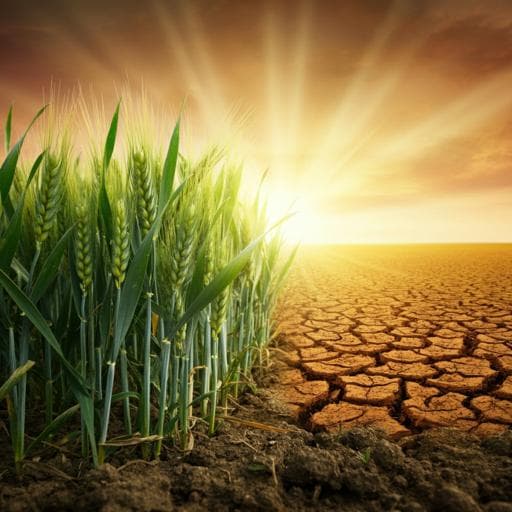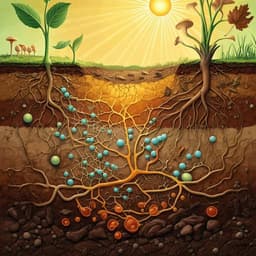
Agriculture
Conservation agriculture improves soil health and sustains crop yields after long-term warming
J. Teng, R. Hou, et al.
This research reveals how conservation agriculture can mitigate the impacts of climate warming on soil health and crop yields, showcasing an impressive 21% increase in soil health compared to conventional practices. Conducted by a team of experts including Jialing Teng and Manuel Delgado-Baquerizo, this study highlights crucial findings for the future of food security.
~3 min • Beginner • English
Introduction
The study addresses how conservation agriculture (no/reduced tillage with permanent residue cover and diverse rotations) performs under long-term climate warming relative to conventional agriculture. Given global food security challenges from warming and soil degradation, the authors examine whether conservation agriculture can maintain or improve soil health and crop yields when temperatures rise. They highlight uncertainties due to complex interactions between warming and management on yields, SOC stocks, and the soil microbiome, and the paucity of long-term field warming experiments in croplands. The aims are to assess (i) the effects of warming on soil health and crop yields under conservation versus conventional agriculture, and (ii) the contribution of the soil microbiome to soil health and yields. Hypotheses: under warming, conservation agriculture enhances crop productivity via increased carbon inputs that stimulate microbial growth and soil carbon accrual; improvements in yield and soil health rely on microbiome changes; and benefits of conservation agriculture accumulate over time.
Literature Review
The paper reviews evidence that conservation agriculture can enhance soil health (notably SOC and biodiversity) and is adopted globally, yet quantitative assessments of its long-term efficacy under warming are scarce. Climate warming often reduces crop yields, especially at low latitudes, and accelerates SOC losses via microbial decomposition; it can also affect nitrogen cycling. Conservation agriculture, through residue retention and reduced tillage, can promote SOC accrual and alleviate water and nutrient limitations, potentially counteracting warming impacts. Microbiome responses are complex: conservation agriculture generally increases microbial biomass and beneficial fungal networks, but warming can reduce microbial diversity in natural systems and may increase soil-borne pathogens. These uncertainties motivate empirical, long-term field experiments in agroecosystems to clarify interactive effects of management and warming on soil health and productivity.
Methodology
Study site: North China Plain, Yucheng Comprehensive Experiment Station (36°50′N, 116°34′E; temperate semi-arid; mean annual temperature 13.6 °C; precipitation 575 mm). Soil: Calcaric Fluvisol. Cropping system: winter wheat (Triticum aestivum L.)–summer maize (Zea mays L.).
Experimental design: Four treatments in a randomized complete block design with four replicates: conservation agriculture with and without warming (residue retention, no tillage), and conventional agriculture with and without warming (residue removal, annual rotary tillage). Plot size 2 m × 2 m. Warming applied continuously since Feb 2010 using infrared heaters (+2 °C surface soil), with dummy heaters on controls. Borders (5 m between blocks, ≥10 m between plots) minimized heat spillover.
Fertilization: Equal total N rates across managements per crop but differing sources. Winter wheat: 285 kg N ha−1 yr−1 (conservation: 112.5 kg mineral fertilizer, 124.5 kg urea, 48 kg residue N; conventional: 112.5 kg mineral fertilizer, 172.5 kg urea). Summer maize: 207 kg N ha−1 yr−1 (conservation: 175 kg urea, 32 kg residue N; conventional: 207 kg urea). Other practices were identical.
Measurements (2010–2019 annually after wheat harvest): Soil temperature and volumetric moisture at 0–15 cm (PT100 thermocouples; FDS100 sensors). Crop yields: hand-harvested 1 m² per plot at physiological maturity; threshed; dry matter basis; converted to t ha−1.
Soil sampling: Three composite samples per plot (five cores each) at 0–5 cm and 5–15 cm depths, sieved (2 mm). In 2020, 17 soil indicators assessed to evaluate cumulative effects: physical (MWD, R0.25, SM, BD), chemical (pH, DOC, SOC, NH4+-N, NO3−-N, DON, TN, AP, TP, AK, TK), biological (MBC, MBN). Methods included wet sieving for aggregates; CaCl2 pH; bulk density from oven-dry mass/volume; SOC and TN by elemental analysis and Kjeldahl; DOC/DN via K2SO4 extraction and TOC analyzer; NH4+/NO3− by KCl extraction; TP by digestion and colorimetry; AP (Olsen); TK/AK by flame photometer; MBC/MBN by chloroform fumigation-extraction and elemental analysis.
Soil health scoring: Cornell Soil Health Assessment (CSHA). Each indicator normalized to CSHA scores; weights derived from PCA (first three PCs with eigenvalues >1, capturing >70% variance). Overall soil health score computed as weighted average of individual scores.
Microbiome: DNA extraction (PowerSoil kit) from 0.25 g soil; 16S rRNA V4–V5 (515F/907R) and fungal ITS (gITS7F/ITS4R) amplicon libraries sequenced on Illumina HiSeq. Processing with USEARCH; ASVs via UNOISE; taxonomy via RDP classifier against SILVA (bacteria) and UNITE (fungi). Rarefaction to ~26,000 (16S) and ~20,000 (ITS) reads per sample. Richness calculated from ASV tables and phylogenies. Fungal guilds (AMF, saprotrophs, plant pathogens) annotated using FUNGuild (probable/highly probable; ASVs <1% excluded).
Statistics: Linear mixed models (lme4) for repeated measures across years (fixed factors: warming, management, their interaction; random intercept: year). Wald Type II χ² tests for significance; pairwise comparisons with emmeans. Two-way ANOVA for 2020 soil parameters and soil health scores. Cohen’s d for warming effect sizes. Temporal trends in effect sizes via linear regression. Microbial community composition via NMDS (Bray–Curtis) and nested PERMANOVA (vegan). Correlations of microbiome and soil/microclimate with soil health and yields via mixed-effects models; hierarchical partitioning (glmm.hp) to assess predictor importance. Analyses in R 4.3.0.
Key Findings
- Microclimate: Warming increased soil temperature and decreased moisture across managements (P<0.05). Conservation agriculture plots were cooler (14.0 °C vs 14.7 °C) and wetter (17.1% vs 15.9%) than conventional (P<0.001).
- Wheat yield: Warming increased winter wheat yields by 9.3% under conservation agriculture and 11.2% under conventional relative to ambient (P<0.001); no average yield difference between managements. The positive warming effect on wheat yield strengthened over time under conservation agriculture (Cohen’s d trend R²=0.50, P=0.049) but not under conventional.
- Maize yield: Affected by management (higher under conservation agriculture; P<0.001) but not by warming.
- Soil health (2020 assessment): Warming increased soil health score under conservation agriculture by 6.3% (0–5 cm) and 8.1% (5–15 cm), and under conventional by 5.2% only at 5–15 cm (P<0.01). Under ambient, conservation agriculture soil health scores exceeded conventional by 21.5% (0–5 cm) and 7.1% (5–15 cm); under warming, advantages increased to 31.4% and 10.1%, respectively.
- Soil attributes: Warming enhanced aggregate stability (MWD, R0.25), DOC, SOC, TN, AK, NO3−-N, MBC, and MBN under conservation agriculture but not under conventional. DOC increased with warming under both managements. Warming increased SOC and MBC only under conservation agriculture (P<0.05), and their positive responses strengthened linearly over time (cumulative benefits over eight years).
- Microbial communities (0–5 cm): Community composition of fungi and bacteria affected by management (R²≈0.089–0.103, P<0.001), warming (R²≈0.014–0.017, P<0.01), and interaction (R²≈0.009–0.010, P<0.05). Bacterial richness unchanged by treatments. Total fungal richness declined under conservation agriculture with warming (−4.1%, P<0.05), driven by decreased saprogen richness; conservation agriculture supported higher AMF richness (P<0.001) and lower saprogen and pathogen richness (P<0.05).
- Microbial communities (5–15 cm): Composition influenced by management, warming, and interaction. Bacterial richness higher under conventional (P<0.01). Conservation agriculture increased AMF and reduced saprogens; under conventional, warming decreased total fungal richness (P<0.01), saprogens (P<0.001), and pathogens (P<0.01).
- Drivers of wheat yield: Under conservation agriculture, wheat yield correlated positively with MBC and negatively with saprogen richness; fungal community composition (5–15 cm) was also linked to yield. Under conventional, soil temperature and moisture, and DOC were most relevant. Overall, yields under conservation agriculture were more influenced by microbiome and soil carbon pools than under conventional.
- Mechanistic link: Stronger associations of SOC and MBC with fungal richness/composition (than with bacteria) under conservation agriculture suggest fungi-mediated carbon accrual mechanisms supporting improved soil health and yields.
Discussion
The findings demonstrate that conservation agriculture enhances soil health and maintains or improves crop yields under long-term warming, addressing uncertainties about management–warming interactions. Positive warming effects on key soil carbon pools (SOC, MBC) and structural stability emerged only under conservation agriculture and intensified over time, indicating cumulative benefits. Yield responses diverged by management: under conservation agriculture, wheat yield increases were linked to improved microbial quality (higher MBC) and shifts in fungal diversity (lower saprogen richness), while under conventional management yield variability was more directly tied to microclimate (temperature, moisture) and DOC. These results support the hypothesis that conservation agriculture fosters carbon inputs and microbial growth that bolster soil health and productivity in a warming climate. The strong coupling between fungi and carbon pools highlights a microbial pathway for SOC accrual and resilience of agroecosystem functions under conservation agriculture.
Conclusion
This long-term field warming experiment shows that conservation agriculture can improve soil health (structure, carbon and nutrient cycling, microbial activity) and sustain crop yields under warming conditions. Warming led to increased SOC and MBC only under conservation agriculture, with benefits strengthening over time, and wheat yield gains were associated with higher MBC and reduced saprogen richness. Conservation agriculture also increased soil health scores relative to conventional, with amplified advantages under warming. These results support conservation agriculture as a climate-smart strategy to adapt to warming and promote sustainable food production. Future research should assess whole-profile SOC dynamics beyond surface soils and conduct regional evaluations across climatic contexts to refine generalization and guide adoption.
Limitations
- SOC and related measurements focused on surface soil (0–15 cm); potential overestimation of whole-profile carbon sequestration is acknowledged and deeper profiles warrant assessment.
- Results may be climate- and region-specific; local climatic conditions (e.g., water availability) influence soil health and yield responses, necessitating careful regional assessments.
- The study assesses a specific wheat–maize rotation and site; extrapolation to other systems should consider management, soil type, and irrigation context.
Related Publications
Explore these studies to deepen your understanding of the subject.







